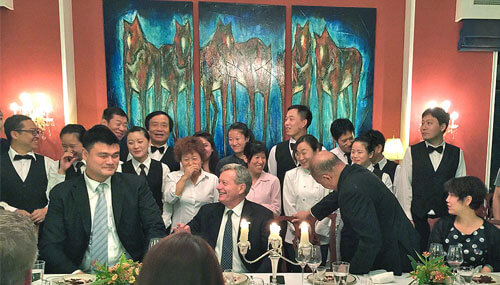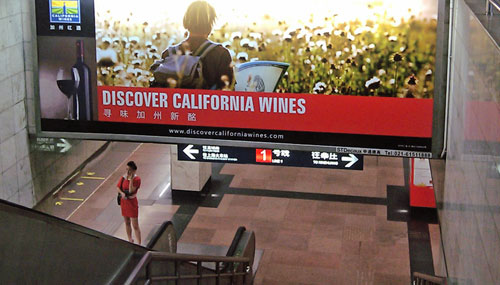US-Asia Business
China's Growing Demand for Red Wine Fuels U.S. Exports
By Vicki Torres

American winemakers see opportunity to grow in China, despite the economic slowdown.
"Certainly this is a dip but people aren't looking at it as doomsday, just an adjustment," said Stephanie Hahn, international marketing manager for Napa Vintners, a trade association in northern California.
"I firmly believe the outlook is good for wine exports to China," said Linsey Gallagher, director of international marketing for the San Francisco-based Wine Institute. "That is the country of most interest to our wineries. Everyone is trying to establish a beachhead in China."
While overall exports to China and Hong Kong decreased about 5% last year compared to 2013, the bigger picture is a 190% increase in U.S. wines sales over the last five years, from $24.8 million in 2009 to $71.3 million in 2014, Gallagher said.
"That's a great story across the board," Gallagher said. "There are a number of factors making China increase in significance in terms of an export market."

"Everyone is trying to establish a beachhead in China."
China's growing middle class
Some of those factors include a population of 1.3 billion with a growing middle class estimated to reach 630 million by 2022. Many of them are younger, have disposable income and aspire to purchase western consumer goods including wine, Gallagher said.
Further, China has not yet developed the western culture of food-and-wine pairing, unlike Korea and Japan where this has already occurred, Gallagher said. So, China represents an emerging market with plenty of room for growth.
The government austerity program begun in 2013 by China's President Xi Jinping reduced lavish banquets that used to be a big channel for wine distribution, Gallagher admitted, but countered that "that situation has been worked through and what's left is a true consumer wine market."
That market is shifting to less expensive, but equally elegant wines, Hahn said. Gift giving is also picking up, especially for wineries that ship wine in dual packs and use the color red to appeal to the Chinese consumer.
Chinese prefer red
For those Chinese currently consuming wine, red wine is preferred. The color red has cultural significance for the Chinese (symbolizing good luck and joy). Red wine is also perceived as having health benefits, Gallagher said.
About 90% of the California wines shipped to China are bold, fruit-driven wines like Zinfandel or cabernet. Many price- and brand-conscious Chinese consumers seek higher-end wines from the Napa Valley, she added.
More accessible market
China's wine market has also become more accessible under a recent arrangement by which wine can be shipped to more westernized Hong Kong and then sent on duty-free to the Chinese mainland, Gallagher said.
And wine consumers in China, especially younger consumers, have access to direct-to-consumer wine-buying sites that have emerged in the last five years such as yesmywine.com and vinhoo.com. With climate-controlled warehouses and distribution channels, the online companies can deliver wine across the entire country with same-day delivery in some locations.
"We see a lot of that," Hahn agreed. "Retailers, restaurants and wine education groups are adding on this online component."
Challenges
Yet distribution remains part of the challenge of getting wine to Chinese consumers. Outside of the online distribution channels, many trucks are not refrigerated and many warehouses are not climate-controlled, Gallagher said. For the individual vintner, that means lack of quality control of the product.
Breaking into the market itself also takes time. The first step is finding a qualified and experienced importer among the numerous import companies in China, most of them with only between three to 10 employees, Hahn said. Then, the business relationship must be nurtured over time.
"If you want to make a go of it, you need to commit to the market and make a presence," Hahn said. "You can't go over once and not show up again. You need to connect with the importer and the trade. It really is a market that you have to build those relationships."
Other challenges can be China's taxes, which can raise the price of a $50 bottle of wine to $150 at the retail level, Hahn said.
Plus, cultural habits also remain a challenge, Gallagher said. Wine is not a traditional beverage in China and sipping wine with food runs counter to a Chinese drinking tradition of downing an entire glass when someone shouts gan bei, the Chinese equivalent of "cheers," she said.But both Gallagher and Hahn said that Chinese appreciation of wine is growing, thanks in part to educational efforts by both organizations and others.

Ridge Vineyard
Mid-size winery Ridge Vineyard entered the Chinese market 15 years ago as part of its overall global strategy begun in the 1970s, said David Amadia, vice president of sales and marketing. The biggest obstacle they faced then was that fine wine was associated with France. California wines lacked brand recognition or were an unknown.
"It was a big challenge in the beginning and it still remains a bit of a challenge," he said.
But the winery got a boost in 2013 when Chinese President Xi Jinping visited Palm Springs and Ridge's Geyserville Zinfandel wine was served at dinner. The winery created gift packs to be sold in China that included the Palm Springs menu and undertook a marketing campaign, all of which helped increase Ridge's stature, Amadia said.

Another major challenge was registering the Ridge Vineyards brand names in China and creating their own Chinese-character bottle labels, Amadia said. Typically, wine importers handle Chinese character wine names; the importers translate English to Chinese and "strip label" the bottle.
When Ridge decided to take over the process themselves, they hired a translation service in Singapore and chose "modern standard" Chinese from among the varieties of Chinese languages in use in various countries in Asia, Amadia said. Modern standard is comprehended in other Asian countries where their wine is sold, for example Taiwan, he said. The process took two years and included a Chinese-language website completed about six months ago.
Today, the winery exports about 2% of its total production of 90,000 cases to China. Ridge Vineyards could probably sell more, but they seek to have balanced distribution in the U.S. and 48 countries to which they export, Amadia said.
Overall, Amadia said that "China is going to be a major market for wines in the future," based on the country's growing prosperity, the number of high-wealth individuals, the increased amount of travel by the Chinese and their growing interest in wine.
"The whole process takes time but their world view will expand and California will be part of that," he said.
Sign up for the Reach Further Newsletter
We’ll keep you in the know about the latest US-Asia business news and trends.
Suscríbase al boletín Reach Further
Lo mantendremos informado sobre las últimas noticias y tendencias comerciales entre Estados Unidos y China.

